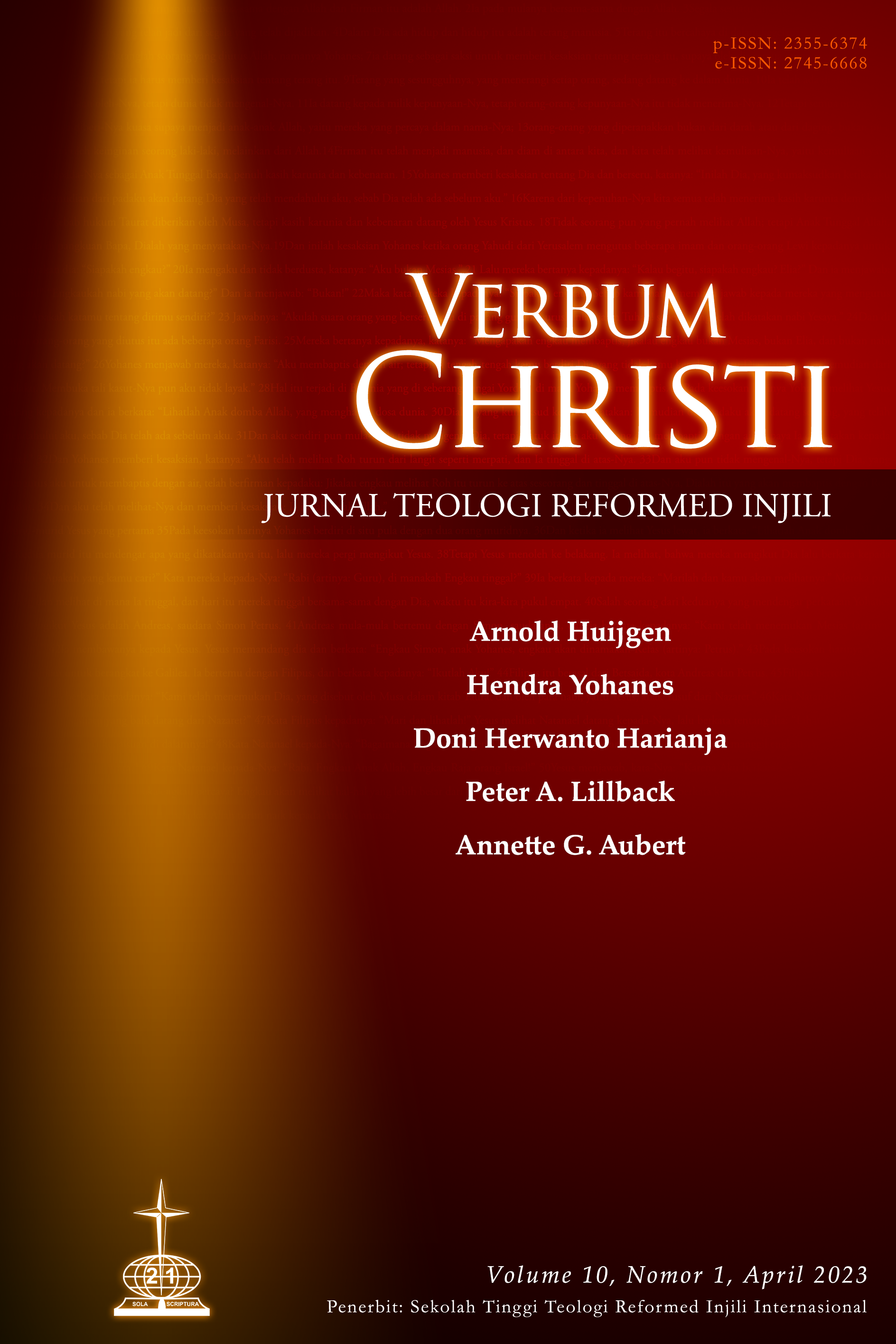Mary
Icon of Grace
DOI:
https://doi.org/10.51688/VC10.1.2023.art1Keywords:
Mary, Mariology, Reformed TheologyAbstract
The article's focus is the way a theological appreciation of Mary can enrich Reformed theology. I will argue that it can do so in the following three ways: (1) Mary is a prime example of faith, an ideal servant of the Lord, and in a sense the mother of all believers; (2) Mary reminds us of God’s faithfulness to the Jewish people, and wards off gnostic heresies; (3) Mary is a symbol of Christianity that has often been misused, but can be put to a good use, and reflection on Mary helps to steer clear of one-sided approaches of the position of women and furthers Reformed reflection on gender. The discussion of each of these aspects is based on exegesis of a passage of Scripture, and considers an aspect of the theological tradition.
Downloads
References
Ambrose of Milan. Expositio Evangelii Secundam Lucam 2:28.
Bauckham, Richard. Gospel Women: Studies of the Named Women in the Gospels. Grand Rapids: Eerdmans, 2002.
———. ‘The Origins and Growth of Western Mariology’. In Chosen by God: Mary in Evangelical Perspective, edited by David F. Wright. London: Marshall Morgan & Scott, 1989.
Beuken, Willem A. M. Jesaja 1–12. Herder Theologischer Kommentar Zum Alten Testament. Freiburg: Herder, 2003.
Bock, Darrell L. Luke 1:1–9:50. Baker Exegetical Commentary on the New Testament. Grand Rapids: Baker, 1994.
Brown, Raymond E. The Birth of the Messiah: A Commentary on the Infancy Narratives in the Gospels of Matthew and Luke. The Anchor Bible Reference Library. New York: Doubleday, 1993.
Brown, Raymond E., and Paul John Achtemeier, eds. Mary in the New Testament: A Collaborative Assessment by Protestant and Roman Catholic Scholars. Philadelphia: Fortress, 1978.
Burger, Christoph. ‘“Hij heeft omgezien naar den lagen staat zijner dienstmaagd”: Gerson, Erasmus, Luther, Zwingli en Calvijn over Lukas 1:48’. In Sola Gratia: Bron voor de Reformatie en uitdaging voor nu. Opstellen aangeboden aan Dr. W. Balke, edited by A. van de Beek and W. M. van Laar. Zoetermeer: Boekencentrum, 2004.
Calvin, John. ‘Commentary Luke 1:34’. In Ioannis Calvini Opera Quae Supersunt Omnia, edited by Guilielmus Baum, Eduardus Cunitz, and Eduardus Reuss. Braunschweig: Schwetschke, 1863.
———. ‘Commentary Matthew 1:25’. In Ioannis Calvini Opera Quae Supersunt Omnia, edited by Guilielmus Baum, Eduardus Cunitz, and Eduardus Reuss. Braunschweig: Schwetschke, 1863.
———. Institutes of the Christian Religion. Translated by Ford Lewis Battles and John T. McNeill. Louisville: Westminster John Knox Press, 2006.
Edwards, James R. The Gospel According to Luke. The Pillar New Testament Commentary. Grand Rapids: Eerdmans, 2015.
Erasmus, Desiderius. Des. Erasmi Roterodami in Novvum Testamentvm Ab Eodem Denuo Recognitum, Annotationes, Ingenti Nuper Accessione per Autorem Locupletatae. Basel: Froben, 1519.
Huijgen, Arnold. Maria: Icoon van genade. Utrecht: KokBoekencentrum, 2021.
Irenaeus. Adversus Haereses.
Jenson, Robert W. ‘A Space for God’. In Mary: Mother of God, edited by Carl E. Braaten and Robert W. Jenson. Grand Rapids: Eerdmans, 2004.
———. Systematic Theology: The Works of God. Vol. 2. Oxford: Oxford University Press, 1999.
Johnson, M. D. ‘Life of Adam and Eve’. In The Old Testament Pseudepigrapha. Vol. 2: Expansions of the ‘Old Testament’ and Legends, Wisdom and Philosophical Literature, Prayers, Psalms, and Odes, Fragments of Lost Judeo–Hellenistic Works, edited by James H. Charlesworth. Garden City: Doubleday, 1985.
Kern, Udo. ‘Der “Arme” bei Meister Eckhart’. Neue Zeitschrift für Systematische Theologie und Religionsphilosophie 29, no. 1 (1987): 1–18. https://doi.org/10.1515/nzst.1987.29.1-3.1.
Leppin, Volker. Die Fremde Reformation: Luthers Mystische Wurzeln. München: C.H. Beck, 2016.
———. ‘Luther’s Roots in Monastic–Mystical Piety’. In The Oxford Handbook of Martin Luther’s Theology, edited by Robert Kolb, Irene Dingel, and L’ubomír Batka. Oxford: Oxford University Press, 2014.
Lohfink, Gerhard, and Ludwig Weimer. Maria – Nicht ohne Israel: Eine neue Sicht der Lehre von der unbefleckten Empfängnis. Freiburg: Herder, 2012.
Luther, Martin. Das Magnificat verdeutschet und ausgelegt, 1521.
———. Predigt am Tage Maria Heimsuchung, Nachmittags (2 July 1531), 1531.
Luz, Ulrich. Das Evangelium nach Matthäus. Zürich: Benziger, 1985.
Ouspensky, Leonid, and Vladimir Lossky. The Meaning of Icons. Crestwood: St. Vladimir’s Seminary Press, 1999.
Parly, Geri. ‘The Origins of Marian Art: The Evolution of Marian Imagery in the Western Church until AD 431’. In Mary: The Complete Resource, edited by Sarah Jane Boss. London: Continuum, 2007.
Rubin, Mary. Mother of God: A History of the Virgin Mary. New Haven: Yale University Press, 2009.
Söll, Georg. Mariologie. Freiburg: Herder, 1978.
Tertullian. De Cultu Feminarum.
Thaidigmann, Edgar. ‘Gottes schöpferisches Sehen: Elemente einer theologischen Sehschule im Anschluß an Luthers Auslegung des Magnificat’. Neue Zeitschrift für Systematische Theologie und Religionsphilosophie 29, no. 1 (1987): 19–39. https://doi.org/10.1515/nzst.1987.29.1-3.19.
Tromp, Johannes. The Life of Adam and Eve in Greek: A Critical Edition. Leiden: Brill, 2005.
Turner, David L. Matthew. Baker Exegetical Commentary on the New Testament. Grand Rapids: Baker, 2008.
Turretin, Francis. Institutio theologiae elencticae: Pars secunda. Genève: Samuel de Tournes, 1688.
van de Beek, A. Lichaam en Geest van Christus: De theologie van de kerk en de Heilige Geest. Zoetermeer: Meinema, 2012.
Visser, Gerard. Gelatenheid: Gemoed en hart Bij Meister Eckhart: Beschouwd in het licht van Aristoteles’ leer van het affectieve. Amsterdam: Boom, 2018.
Warner, Marina. Alone of All Her Sex: The Myth and the Cult of the Virgin Mary. Oxford: Oxford University Press, 2017.
Downloads
Published
How to Cite
Issue
Section
License
This article follows the terms of Creative Commons Attribution-NonCommercial 4.0 International License.
Copyright (c) 2023 Verbum Christi: Journal of Reformed Evangelical Theology. It is held by the journal with the author's consent.

